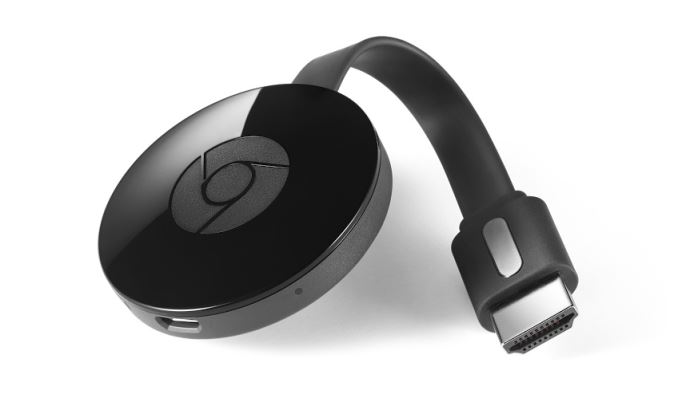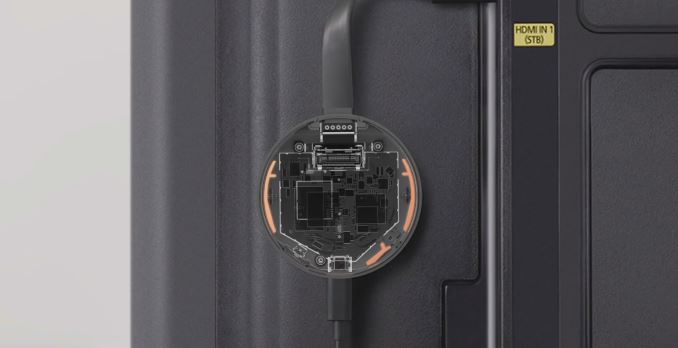Google’s Chromecast 2 is Powered By Marvell’s ARMADA 1500 Mini Plus - Dual-Core Cortex-A7
by Ryan Smith on October 5, 2015 8:50 PM EST- Posted in
- Mobile
- Marvell
- Media Player
- Smartphones
- Android
- SoCs
- Chromecast

When Google originally announced the second-generation Chromecast last week, in typical Google fashion they focused on features and uses over specifications. Given the capabilities of the new product we knew that there had to have been some changes – at a minimum the wireless component has changed – and thanks to a press release from Marvell we finally know what chips are in the new media receiver.
The Chromecast 2 is powered by Marvell’s ARMADA 1500 Mini Plus (88DE3006), one of Marvell’s lower-end “digital entertainment processors.” The Mini Plus is the successor to the ARMADA 1500 Mini (88DE3005), which in turn was first introduced for the Chromecast 1 back in 2013. Like the original Mini, the Mini Plus is essentially tailor-made for the Chromecast, as it’s geared to be a low-cost solution for simple streaming devices.
| Google Chromecast Family | |||||
| Chromecast (1) | Chromecast (2) | Chromecast Audio | |||
| SoC | Marvell ARMADA 1500 Mini SoC (88DE3005) | Marvell ARMADA 1500 Mini Plus SoC (88DE3006) | Marvell ARMADA 1500 Mini Plus SoC (88DE3006) | ||
| CPU | 1x Cortex-A9 | 2x Cortex-A7 (1.3GHz?) | 2x Cortex-A7 (1.3GHz?) | ||
| Memory | 512MB | 512MB | N/A | ||
| Wireless | 1x1 2.4GHz 802.11n | 1x1 2.4GHz/5GHz 802.11ac | 1x1 2.4GHz/5GHz 802.11ac | ||
| Display Output | 1080p | 1080p | N/A | ||
| Max Video Decode | 1080p30 | 1080p | N/A | ||
| Ports | HDMI Micro-USB (Power) |
HDMI Micro-USB (Power) |
3.5mm Combo Jack (Analog + Optical Audio) Micro-USB (Power) |
||
| Launch Date | 07/24/2013 | 09/29/2015 | 09/29/2015 | ||
| Launch Price | $35 | $35 | $35 | ||
Unfortunately in-depth details on the Mini Plus are hard to come by at the moment – and Marvell never published all that much about the original Mini either – but we do know that unlike the original Mini, Marvell has put in a bit more customization work into the Mini Plus. The original Mini was in a few ways a cut down version of Marvell’s more powerful Cortex-A9 based chips, such as implementing just a single CPU core versus multiple cores. This time around the Mini Plus drops the single Cortex-A9 for a dual-core Cortex-A7 implementation, and is the only ARMADA product utilizing A7.
Officially Marvell isn’t specifying clockspeeds, however they are advertising that the Mini Plus gets “up to 4900 DMIPS”. This is notable since we know that the Cortex-A7 has an estimated DMIPS/MHz ratio of 1.9, with puts the maximum CPU clockspeed at roughly around 1.3GHz (4900 DMIPS / 2 cores / 1.9 ratio = ~1289). Meanwhile according to Marvell’s press release the Mini Plus is supposed to deliver 2.5x the CPU perf of the Mini, which is especially interesting because A7, though not too far off of A9, is still a simpler part with lower IPC. So the fact that CPU performance is ahead of the A9-based Mini even after factoring out the second CPU core (1.25x) bodes well that Google hasn’t traded an immediate multi-threaded performance cap for a single-threaded performance cap. Curiously this implies that the Mini in the original Chromecast was clocked quite low (~800MHz), but for the moment these are the numbers we have to work with.
As for the GPU, Marvell is stating even less, only that it’s an OpenGL ES 2.0 part. ES 2.0 parts are still very common in pure media streaming devices and TVs, as for the most part you don’t need much more GPU performance than is necessary to do basic drawing and compositing at 1080p. All of the other ARMADA 1500 parts have using Vivante GPUs, and I expect the story is the same for the Mini Plus.
The bigger question on the video processing side is whether the Mini Plus has HEVC support or not. All ARMADA 1500 parts launched since mid-2014 have included HEVC support, however as the Mini Plus is a low-cost part, it remains to be seen whether Marvell was willing to spend the die space and licensing costs on support for HEVC in a device only designed for 1080p in the first place. By and large, HEVC is being utilized by media streaming firms for 4K media rather than 1080p.
Finally, Marvell’s press release also opens up on the wireless networking chip used in the Mini Plus. Here Marvell has dropped the 3rd party AzureWave solution for their own Avastar 88W8887 solution. The Avastar 88W8887 (ed: that’s a lot of eights) is a “quad radio” solution, offering support for WiFi, Bluetooth, NFC, and FM radio receive. In the case of the Chromecast 2, Google is only making use of the WiFi functionality, where the 88W8887 supports 802.11ac with 1 spatial stream, allowing it to transfer up to 433Mbps over 5GHz. Otherwise it’s interesting to note that of all of the technical changes that come with the switch from the Mini to the Mini Plus, it’s the improved WiFi capabilities from the 88W8887 that have seen the most promotion from Google itself.
Source: Marvell











18 Comments
View All Comments
zepi - Tuesday, October 6, 2015 - link
It is almost certan streaming services will move to use HEVC or VP9 even for HD / SD streaming to reduce costs.Licensing issues, cost of transcoding, decoding, playback device support etc. will play role in deciding which of the two (HEVC / VP9) wins or if both get used. But it is almost certain that H.264 will be abandoned eventually, because it will allow these companies to reduce bitrates / storage costs. This lowers their costs -> streaming companies will go for it as soon as possible.
thepaleobiker - Tuesday, October 6, 2015 - link
The "Alliance for Open Media" is working on a joint future Codec to replace all current licensed codecs, and is supported by all the big guns - Google, Amazon, Netflix, Mozilla, etc--> http://techcrunch.com/2015/09/01/amazon-netflix-go...
Regards,
Vish
Ryan Smith - Tuesday, October 6, 2015 - link
For what it's worth, the most recent ARMADA 1500, the Ultra, does support VP9. However there's no guarantee the Mini Plus supports it.adriangb - Tuesday, October 6, 2015 - link
Considering the hardware supports Bluetooth, I would've liked to see 1 single device that does audio and video and outputs 3.5mm and HDMI. Usage case: stream any audio from iPhone, Android, etc. without needing Chromecast support. I understand that Google wants to push their ecosystem but I've found that most people wouldn't buy a Chromecast until they've used one, and in that regard enabling Bluetooth audio streaming could open the door to many homes.Bigd60 - Tuesday, October 6, 2015 - link
Will it be possible to cast Sky GO from phone or tablet to TV. This was the only downside of Chromecast 1.PrinceGaz - Tuesday, October 6, 2015 - link
Probably not: Sky want to limit Sky Go as being only able to be watched on the screen of the computer, tablet or phone which is playing it. For instance, their Android app detects and prevents playback if screen-casting is enabled or if the device is rooted. The best way to watch Sky Go on a TV is to use an old or dedicated home-theatre PC for that purpose.The reason Sky do this is because they want you to pay for a multiroom subscription for the additional TVs in the account holder's home (and they definitely do not want friends or family of the Sky subscriber using Sky Go to watch at a different address for free). If you want the freedom to watch Sky content on pretty much any device or screen, they do offer NOW TV which is a subscription service, but rather expensive for what is on offer.
JesseKramer - Wednesday, October 7, 2015 - link
It is very frustrating that google has decided to release two products, when they could have just added an extra output to the chromecast 2.I'll probably buy a Chromecast Audio, because that is the functionality I want. But it seems incredibly arbitrary that these are two separate products.
velanapontinha - Wednesday, October 7, 2015 - link
That was my first though when I read upon the CC2 launch. They are blatantly going for the "buy both" approach. Irritating, to say the least.